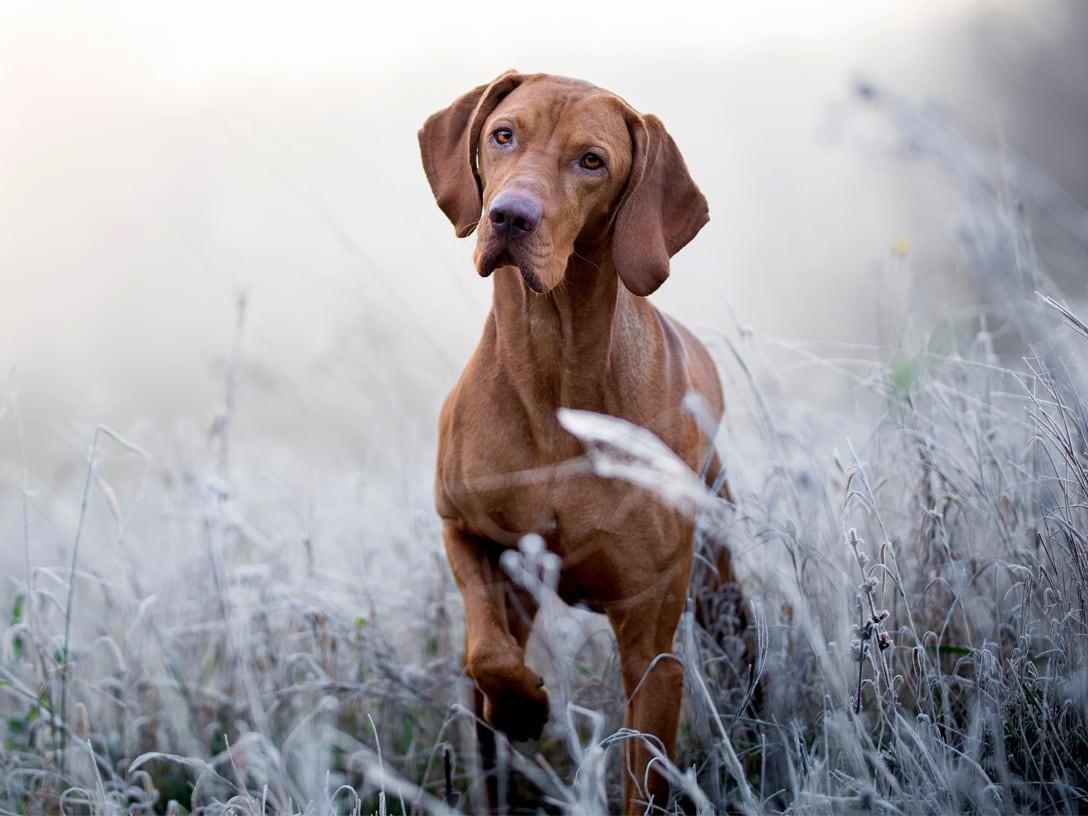Winter is right around the corner. With the drop in temperature comes an increase in health risks for your pet. The weather’s cold and it’s the perfect time to snuggle up or exercise with your pets! However, you will need to leave the house with your pets from time to time, and we’re here to help make sure you do so safely. To help ensure that your pet’s winter is as enjoyable and safe as possible, we’ve come up with a few pet safety winter tips for you to follow.
Our Winter Tips
1. Know the signs of hypothermia and frostbite
If it’s too cold for you, it’s probably too cold for your pets as well! Don’t keep your pets outside for too long when it’s cold out or they could develop frostbite or hypothermia, two potentially fatal conditions.
Frostbite is an injury caused by extremely cold weather that damages the skin and underlying tissues. It usually occurs on small, exposed areas of the body. Symptoms to look out for are blue or gray discoloration of the skin, blisters, swelling, skin being cold, firm, and dry.
Hypothermia is a dangerous medical condition that occurs when your pet’s body temperature drops too low. For dogs, mild hypothermia occurs when their body temperature reaches between 90-99 degrees Fahrenheit and severe hypothermia will occur if their temperature drops to 82 degrees or less. Symptoms of hypothermia include shivering, muscle stiffness, paleness, weakness, difficulty or rapid breathing, or loss of consciousness.
If you suspect your pet has either frostbite or hypothermia, bring him to a warm area and contact your vet immediately. Learn more about how cold affects cats.
2. Manage how much your pet is eating
Pets will need extra energy to utilize for warmth during the winter. They rely on calories for energy, so a little extra food will go a long way. These extra calories will help fuel activities that keep them warm, such as exercising and shivering.
Depending on their size and coat type, the number of extra calories they’ll need will vary. Dogs and cats with thin, short coats and low bodyfat will need more calories than pets with a higher fat density and a thicker coat.
Also, make sure to also check that they always have water and that it’s not frozen if it’s outside. Use plastic bowls instead of metal to prevent your pet’s tongue getting stuck to the bowl!
3. Never leave your pet in a parked car
You may have heard to never leave your pet in a parked car during the summer, and the same goes for winter. Just like how cars can heat up very quickly in the sun, they can also cool down quickly in the winter. They hold cold air in and act like a refrigerator, putting your pet at risk.
4. Protect those paws!
Not only can the winter weather be too cold for your pet’s paws, but chemicals used to melt ice can also harm their feet! After a walk, use a damp towel to gently remove irritants like salt and other chemicals from their paws. Also, check for signs that their feet are too cold during your walks. If they are frequently lifting their paws, whining, stopping, or trying to get on other surfaces, it’s likely that the floor is making their feet hurt. Exposure to dry air, rain, sleet, and snow can cause itchy, uncomfortable skin and chapped paws. Consider buying pet booties to prevent paw irritation during the winter. Besides keeping their feet safe, they are a super cute accessory!
5. Monitor outdoor time
When the temperature drops, take time to acclimate your pets to the change. This can help their bodies adjust to freezing temperatures and make it safer for them to be outside.
Keep outdoor trips short. Make sure you have plenty of daylight left so that it won’t get too dark and cold while you’re out. If you’re walking after sunset, use a reflective leash to keep you and your pet visible. Also, make sure your pets are leashed and chipped before you go out. Snow can cover familiar scents and make it harder for your pets to find their way home, so you should take precautions to keep them safe. Make sure they have identification on them with information that is accurate and legible.
6. Provide an indoor bathroom
On winter days that are especially cold, it may be unsafe for your pet to go outside at all. While some pets are used to using the bathroom outside, on these days you’ll need to create an indoor bathroom solution to keep them safe. Keeping some training pads on hand is useful when the weather is too cold. Place these pads in a warm area of the house and make sure your dog has been trained to know how to use them. If they absolutely must go to the bathroom outside, shovel away some snow and create a designated area for them to go.
If your litter boxes are stowed away in areas like the garage or basement, they might get too cold in the winter as well! To make sure your cat can comfortably go, bring your litter boxes to a warmer area of the house.
7. Keep antifreeze away from pets
Antifreeze can be an important tool in the winter. However, because it often contains ethylene glycol, it can be very dangerous for your pets to ingest. Many types of antifreeze have a sweet smell and taste that can attract animals, so it’s important to keep your pets away from it and to clean any spills. Even a very small amount can be fatal.
Symptoms of antifreeze poisoning include drooling, seizures, excessive thirst and urination, and vomiting. If you suspect that your pet has ingested antifreeze, contact your veterinarian immediately.
8. Keep up with grooming
Grooming needs to be maintained all throughout the year, but especially during winter! Trim the hair on your pet’s paws to prevent salt and other harmful chemicals from getting stuck there. Keep up with regular baths to prevent dry skin and comb their coat regularly to detangle their fur. If you wait until the spring to brush their coat, you’ll likely find it’s full of tangles and mats that are very hard to work through.
Key takeaways
The winter can be a great time to bond and spend extra time with your pet inside. Before you snuggle up on the couch all winter, make sure you’re taking the proper precautions to keep them safe. Know the signs of hypothermia and frostbite, give them some extra calories, keep their paws safe, manage their outdoor time properly, and keep up with their grooming. Never leave them in a parked car and keep your antifreeze way out of reach! If you notice your pet is exhibiting any signs that they are too cold, get them to a warm, dry area and call your vet.
How Spot Pet Insurance Can Help
Spot Pet Insurance plans can help provide you with additional financial support and peace of mind if your pet becomes ill in the wintertime. Spots offers two base plans; accident-only or accident and illness which can help cover the cost of treatment for hypothermia, frostbite, and other conditions that your pet may be more susceptible to during the winter season (and throughout the rest of the year). Spot's accident and illness plans also cover the cost of treatment for ingested objects or toxins, like antifreeze.

I've had the privilege of immersing myself in the realm of pet safety. As the owner of an energetic mini golden doodle, I know just how stressful being a pet owner can be. I am dedicated to ensuring our beloved pets enjoy a life brimming with good health.












